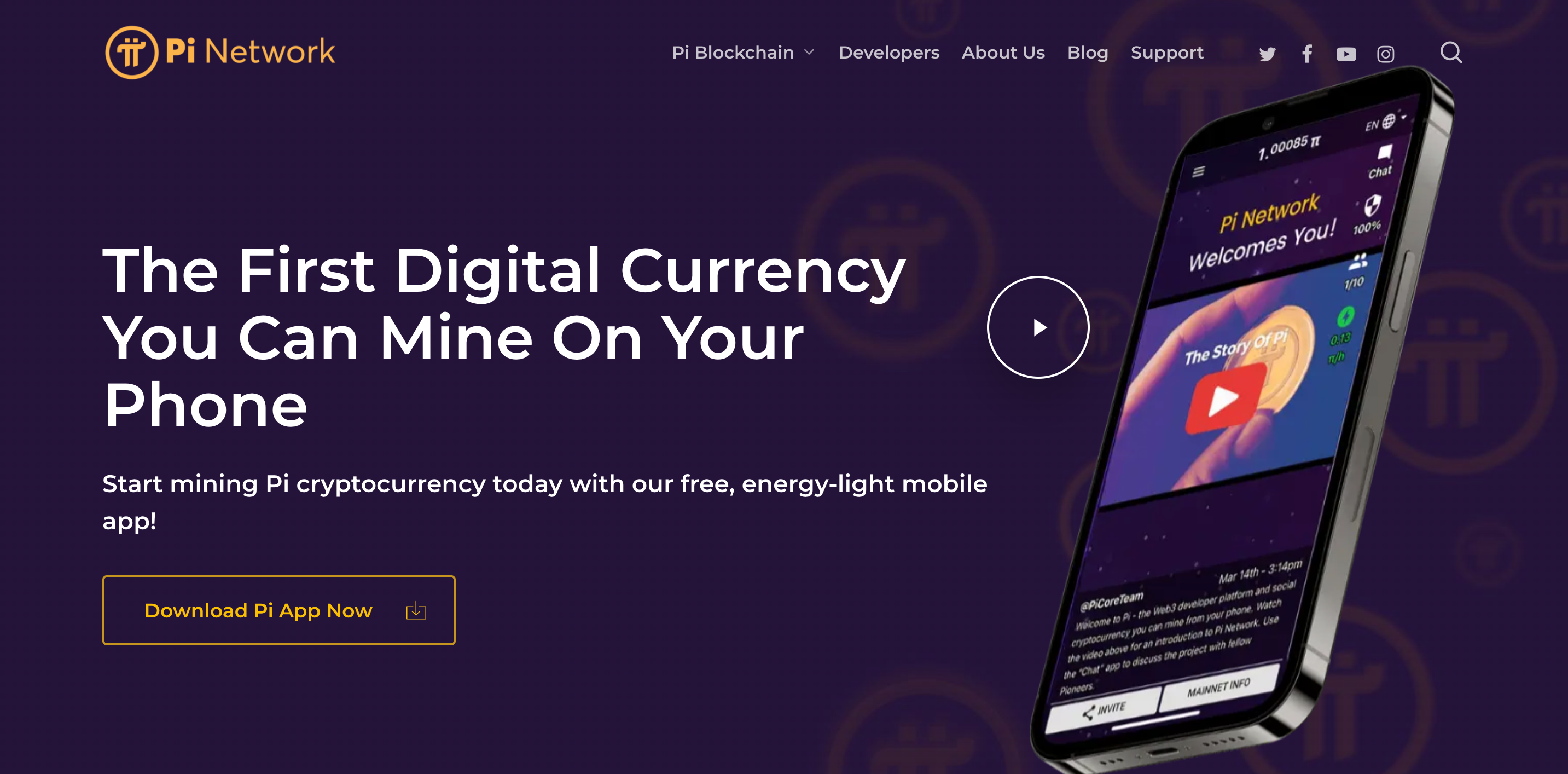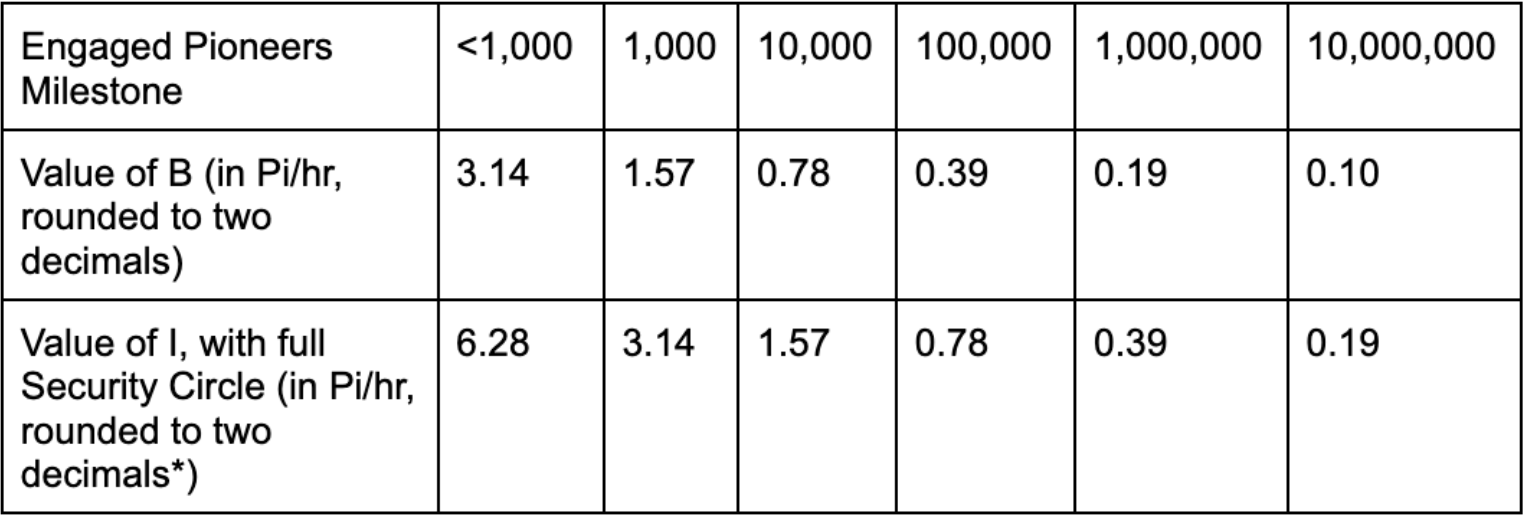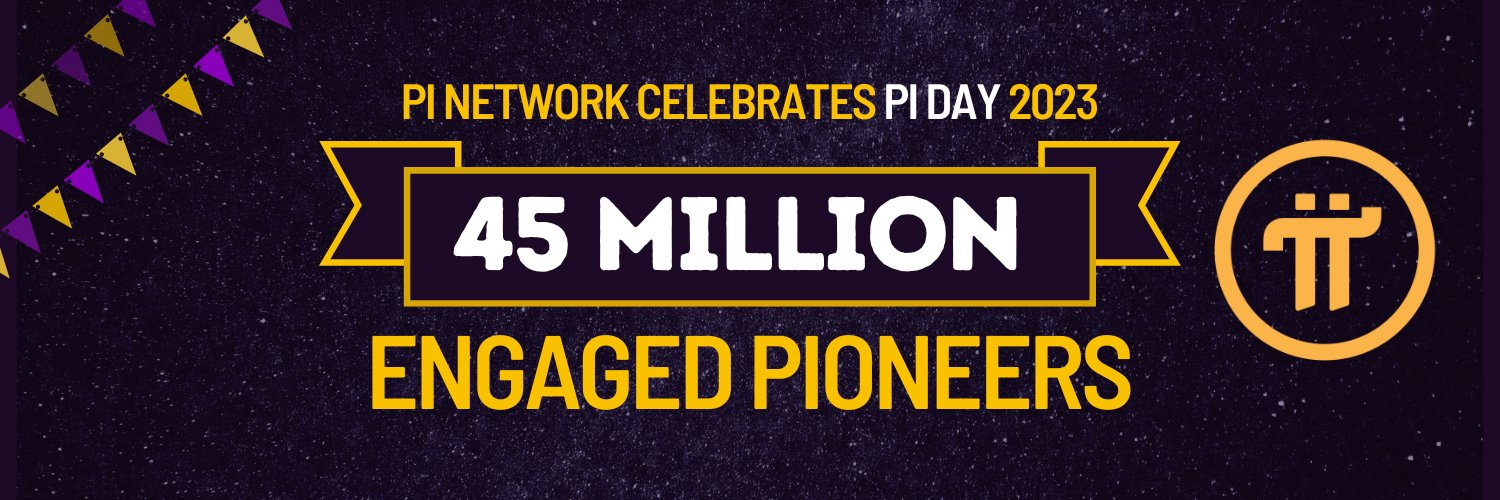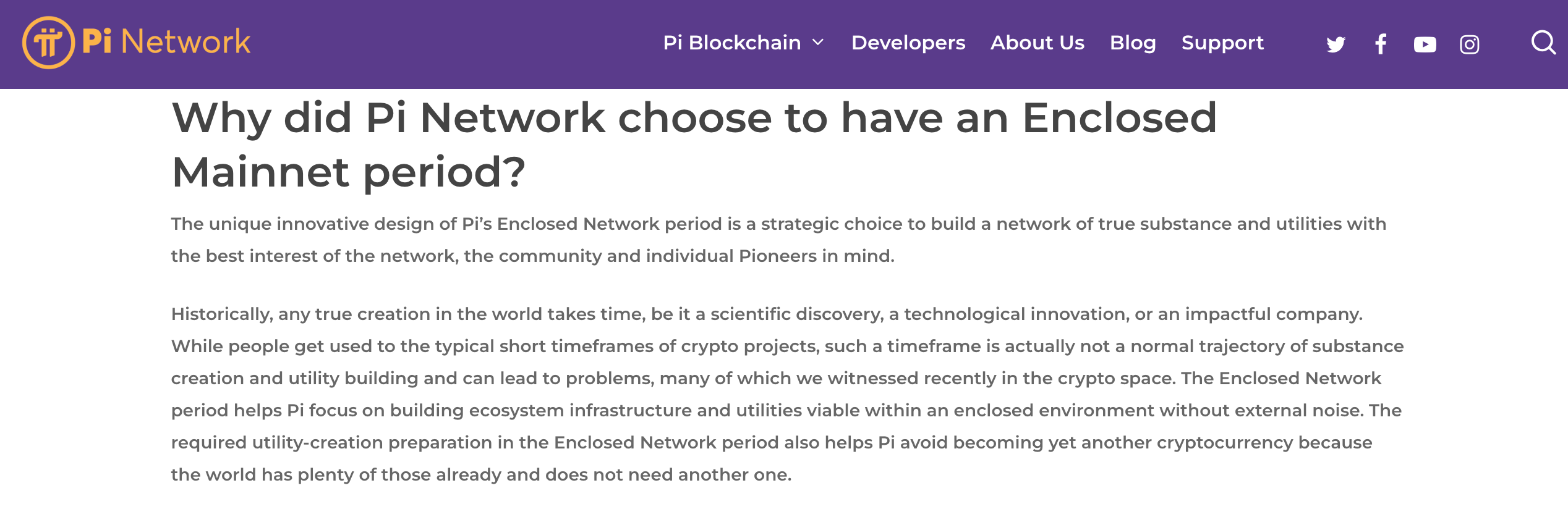The cryptocurrency market is still quite new, and there is a lot of room for improvement and innovation. And because it’s new and it involves large sums of money, the crypto market is kind of a wild west.
Many have tried and failed to recreate a new and improved Bitcoin. Some people came up with new concepts, but they didn’t seem to get anywhere near the success of Bitcoin and Ethereum.
And truth be told, the more innovative, the more complicated the cryptocurrency matter gets.
Therefore, a team of Standford PhDs tackled the challenge of creating PI, a user-friendly inclusive currency that could see massive worldwide adoption.
And to do so, they made use of the Stellar Consensus Protocol, another concept born at Stanford University.
So, in this article, you will find out what this crypto project is about and how it behaves on the market.
What Is Pi?

Well, Pi is 3.14159265359 and is a mathematical constant. But that’s not what we’re here for.
We’re here to talk about the Pi Network. Pi Network is a cryptocurrency project developed by Standford PhDs and graduates — Nicolas Kokkalis, Chengdiao Fan, and Vince McPhillip designed to run on mobile phones.
The goal is to create a blockchain that works with the Stellar Consensus Protocol (SCP) to make it as resource-efficient and user-friendly as possible by employing a “security circles” system.
How Was Pi Network Launched?
It all started on March 14, 2019 (the official Pi Day), when the developers launched their mobile app. They marketed it as a free, battery-friendly mobile mining app that you only have to access once a day for it to continue mining for you on its own.
The mining rate started at 3.1 Pi/h and halved every time the number of users grew over a certain number.

The community grew larger and larger, and by October 2022, the app had already got over 45 million engaged users with a 0.0147 Pi/h base mining rate. Moreover, it is essential to note that the Pi base mining rate adjusts on the first day of every month.

“Over 45 million people making free loads of money in one year? That’s amazing!”

Yes, it is, but that’s not actually what happens. Inside the white paper, we can see that the Pi network project has three stages: beta, testnet, and mainnet.
Currently, it is in the Enclosed Mainnet phase, meaning that users can complete the KYC (Know Your Customer) procedure and move their digital assets on the mainnet.
The team launched the Pi Mainnet blockchain on December 28, 2021, and since then, it has been in an enclosed mainnet stage.
If you are wondering why Pi Network decided to pass through an enclosed mainnet period (also called the Enclosed Network Period of Mainnet), it is mainly because the team behind Pi Network aims to build a strong and trustworthy ecosystem. And to do that, developers made this strategic choice in order to offer users a network of true substance and truly valuable utilities.

As for the Pi mining, “the mining” is not actually mining as it’s understood in the crypto market. What we commonly understand as mining doesn’t even work in an SCP.
“So, is it fake or a scam?”
Neither! It’s a project in a testnet state that uses common terms to hook people in. So, in order to answer the question “Is Pi Network legit?” we first need to understand how it works.
How Does Pi Network Work?
After analyzing the white paper and taking a deeper look at this project, we can understand why the Pi Network project was designed and advertised as it is.
- The project’s goal is mass adoption and is targeted to a large audience. And because most people had heard of Bitcoin, it was essential to compare and point out Bitcoin’s faults and Pi’s advantages.
- Mass adoption has to go hand in hand with wide distribution. Through the app, the Pi token distributes pre-minted tokens to its user base. It is most likely called “mining” because the term is easier to understand.
- Building a blockchain from the ground is no easy task, and most projects end up being hacked because of weak network security. Through SCP, the network’s security improves greatly. However, as SCP is quite a complicated thing to understand (as we’ll see below), they only emphasized the security circles system, which is incentivized.
- Pi also states it’s the “first digital currency you can mine on your phone.” But actually, Monero was the first with the Minergate app. And even if there were others before, they did drain the battery and used more data. But as the Pi network’s app simulates a faucet, you don’t even have to be connected to the internet as long as you check in once every 24 hours.
The use of buzzwords to gather a vast community is essential to how the Pi cryptocurrency is thought out and the Byzantine Fault Tolerant System it employs, as we will see.
Who Are the Pi Network Users?
Pi Network users are distributed globally. They help to grow the network by performing different functions to keep the network going.
Pioneers
The pioneers are users who keep the network busy by just logging into the free Pi mining app on a daily basis and confirming that they are not robots. This way, they manage to mine Pi. As of the beginning of 2023, there are over 45 million Pioneers on Pi Network.
Contributors
Contributors build a trusted network by providing a list of pioneers they know personally. This can bring an incentive for them, thus keeping them close to the crypto project.
Contributors usually have a different mining rate, depending on how many Pioneers they refer to the Pi ecosystem. Thus, if a Contributor refers several Pioneers, they will have a higher mining rate.
However, it is essential to note that Contributors’ mining rates highly depend on Pioneers’ activity. If a Contributor refers a Pioneer and the latter does not mine Pi constantly, the Contributor’s mining rate will not stay the same.
Ambassadors
As of March 2023, Pi Network has introduced specific ambassador programs for users. Ambassadors earn Pi when they verify and register new applications in the ecosystem.
This initiative came as a way of contributing to the Pi ecosystem specially designed for users who do not have product development or software programming knowledge.
Node
A node is a user who combines the first two roles and operates a Pi network node. This category of network users helps to validate the network and keep its integrity in addition to playing the other roles.
Everyone playing any of the above roles can earn new Pi coins for their roles in sustaining the network. And while the Pi price may not be well established now, it will be when the project enters the Open Mainnet stage.
Pi Network Evolution and Phases
The design of the Pi network makes it very convenient to use, and thanks to this, many users decided to become part of it. Within two months of its launch, the network had already recorded over 200,000 active users.
As of the beginning of February 2021, the network had at least 2.5 million miners who mined the cryptocurrency using different devices and more than 10 million users in all.
The number of Pi Network active users is constantly growing, and this is proof that crypto enthusiasts truly believe in the project and are willing to mine Pi now and see the results later.
Pi Network Phases
The roadmap of the Pi Network involves 3 main phases:
- Phase 1 – Design, Distribution, Trust Graph Bootstrap;
- Phase 2 – Testnet;
- Phase 3 – Mainnet. At the moment, the Miannet stage is divided into 2 parts. Pi Network is currently in the Enclosed Network Mainnet period, as we also mentioned before.
The Pi crypto will be available on cryptocurrency exchanges at the end of the 3rd phase, the mainnet. At that point, those who are mining now will be able to trade their Pi crypto for other tokens or coins.
The project is still in quite an early stage, and new miners can be added strictly by invitation. At the time of writing, Pi Network reached over 45 million engaged pioneers (miners).
Stellar Consensus Protocol
Generally, a blockchain works as a decentralized digital ledger sustained through a distributed network of computers. In a distributed system, the participants of a cryptocurrency network need to achieve consensus safely and efficiently regularly.
However, reaching a consensus is quite difficult, especially when some of the nodes are likely to fail or act dishonestly. But through the Byzantine Fault Tolerant System, a blockchain can continue operating even when some nodes fail to communicate.
Sidenote. Byzantine Fault Tolerance (BFT) is the property of a system to resist the types of failures that come from nodes failing to communicate or act maliciously and continue to operate as long as there is a majority of nodes in agreement.
Bitcoin’s Proof of Work mechanism has proven to be one of the most secure implementations of BFT for blockchain. But the complex cryptographic puzzles employed by Bitcoin’s PoW turned the network rather slow and inefficient from an energy consumption point of view.
Therefore, many other projects implemented protocols with derived BFT to create improved networks based on voting that are faster and cheaper. However, they come up with several disadvantages, like a higher risk of accidental forks, centralization, and the appearance of powerful whales.
Federated Byzantine Agreement Protocol
In 2015, Professor Mazières from Stanford introduced an alternative to Byzantine Fault Tolerance called The Federated Byzantine Agreement.
The concept is based on quorums that achieve consensus, employing overlapped quorum slices formed by validators.
SCP is the first general FBA protocol that gives an open membership system. So, how does Stellar’s Consensus Protocol work?
In SCP, each validator decides which validators they trust to form a quorum slice. Therefore, there is no need for a central authority to decide on a validator’s list.
In a distributed asynchronous system, a consensus mechanism must prefer 2 of the following 3 properties:
- Fault-tolerance – the ability of a system to survive the failure of a validator;
- Liveness – a system’s ability to always close a ledger, even if it causes a fork;
- Safety – the ability of a system to prevent an error from entering its ledger, eventually stopping its progress.
The SCP version of the Federated Byzantine Agreement prefers fault tolerance and safety. Also, there is no mining process. There is only a 3-5 second voting process where messages pass around to reach a consensus.
And because of the safety preference over liveness, there is no risk of a fork making you wait for a few ledgers, so a transaction is permanent from the first time it reaches consensus.
Federated Byzantine Agreement is asymptotically secure concerning the security of the network since applying computing power to sabotage consensus is impossible.
And even if there remains the possibility of bad actors colluding, it is virtually impossible for them to form a majority because the network is formed of a complex web of overlapping quorum slices.
Unauthorized Pi Network Token Listings
On December 29, 2022, Huobi Global, a popular crypto exchange, announced that they would be listing a new digital currency called PI, which is the native token of the Pi Network.
CoinGecko data shows that the price of Pi increased by 461.3% from $47.20 to $249.84 between December 29, 2022, and December 31, 2022.
However, Pi Network quickly responded by warning people not to buy or sell this token on Huobi or any other exchanges. They stated that they did not give permission for any crypto exchange to list their token and were not involved in the listing process.
The Pi Network team also issued an official statement reminding their users that they should be cautious when dealing with any third-party exchanges or actors who claim to be affiliated with the Pi Network.
Pi Network warned that these actions could result in loss or damage to the users. They also requested for these unauthorized posts and exchange listings to be removed.
It’s important to note that during the Enclosed Mainnet period, it is prohibited to trade PI through any exchange, and doing so would be against the Pi Network’s policies.
So be very careful and don’t put money in without documenting from reliable sources before. In Pi Network’s case, the Pi team keeps users informed through the official Pi Network website and various updates posted on the Pi mining app.
Furthermore, Pi Network has recently launched a new app called Pi Browser, where the project offers various information regarding the Pi cryptocurrency, Pi blockchain, Pi Wallet, and the overall Pi project.
Pi Coin Price Prediction and Value
Unfortunately, market data is untracked on CoinMarketCap for the real Pi Coin. Pi live data is also unavailable. So, we’re yet to get data for a reliable Pi Coin price prediction.
As Pi is still in its Enclosed Mainnet phase, it is quite difficult to predict the price of Pi tokens. Miners have expressed optimism about its future value because of the efficiency and ease of use for mining.
However, although it has not yet launched on exchanges and has no real value, for now, the cryptocurrency exchanges are giving Pi Network price predictions rather based on users’ opinions.
Changelly predicted that the price of Pi would be $0.16 by the beginning of 2020. This did not come to pass, and Pi Network’s value is currently $0.00. Moreover, it’s already early 2023, and it hasn’t even been fully launched on the mainnet yet.
However, this is an opportunity for new miners to enter the project and start mining Pi coins so that they will have as much of the crypto as possible before trading commences.
Changelly also predicts that the price of Pi may rise to $1 by 2025, and those who already have cryptocurrencies could profit significantly. According to their price prediction, if Pi Network becomes highly promoted by various celebrities and crypto-related businesses, it might reach the market cap of XRP.
WalletInvestor, on the other hand, predicts that Pi crypto will have a price lower than $0.5 by 2025. And it is no wonder that predictions differ that much, considering that there has not been a Pi Coin launch yet, and such websites base their price predictions on other entities’ opinions.
Thus, it is highly important to thoroughly research every website you decide to use in order to stay informed about the Pi Network cryptocurrency. And as we have previously mentioned, checking the official Pi Network website will offer you significantly more news and updates and assure you that the information is trustworthy.
FAQ
Is Pi Network worth Anything?
At the moment of writing, the pi Coin value does not truly exist. The main reason is that the Pi Network price cannot increase while the project is still in the Enclosed Mainnet period.
How Much Is Pi Network Worth Now?
Currently, Pi Network is not worth anything. However, several websites post daily updates regarding how the market feels about Pi Network and the Pi Coin value.
Nevertheless, it is essential to keep in mind that the “How much is Pi Network worth now?” question still has no concrete answer.
The Pi Coin value is yet to be discovered when the project lists the Pi cryptocurrency on various cryptocurrency exchanges.
Is Pi Network Safe?
Simply put, it strongly depends on the research users perform before joining Pi Network. The crypto project seems to have been built pretty well, and the team behind it can be trustworthy.
However, some users believe that Pi Network is just another pyramid scheme. Pyramid schemes are quite popular all over the world, but they are also illegal in several countries.
Does Pi Network Have a Future?
Yes, it is possible that Pi Network will have quite a bright future. According to various specialized websites, Pi Network might increase in value after being launched on the market. For instance, some websites predict that the Pi coins might even reach values higher than $50.
However, it is essential to note that the prediction is not based on the Pi Coin price history, as there is no such thing at the moment. Thus, Pi users should still be cautious when including Pi Network in their investment plan.
In Conclusion
Launched on Pi Day, Pi Network is a cryptocurrency project developed by Standford PhDs and graduates Nicolas Kokkalis, Chengdiao Fan, and Vince McPhillip designed to run on mobile phones.
The project is currently in the testnet phase, and the Pi Network app is only a simulation of a faucet. The Pi token holds no value at the moment and cannot be traded on exchanges.
Pi Network is built on top of the Stellar Consensus Protocol. The Stellar Consensus Protocol (SCP) is a system that works based on quorums that achieve consensus, employing overlapped quorum slices formed by validators.
In order to build an inclusive and functional network, every role is built around producing trustworthiness.
The Pi Network price is likely to grow when it finally lists on exchanges. The project’s team plans to make PiCoin the most popular in the future. Some people already call it “The Future Bitcoin.”
If you wish to be a part of the Pi ecosystem and mine Pi coins on your mobile devices, you can still do that now and be a part of the future Pi Network phases.
While it is still pretty uncertain, the Pi Network price prediction shows a bright future for this cryptocurrency.

